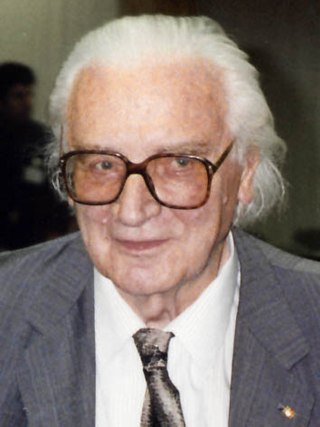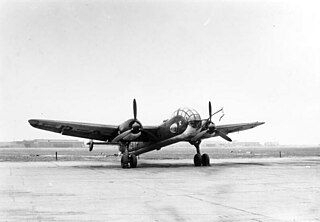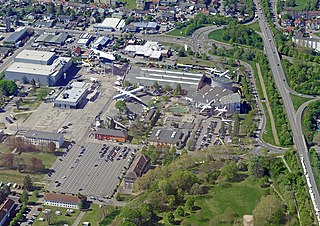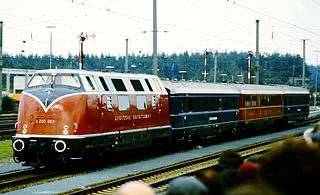
Konrad Ernst Otto Zuse was a German civil engineer, pioneering computer scientist, inventor and businessman. His greatest achievement was the world's first programmable computer; the functional program-controlled Turing-complete Z3 became operational in May 1941. Thanks to this machine and its predecessors, Zuse is regarded by some as the inventor and father of the modern computer.

The Junkers Ju 52/3m is a transport aircraft that was designed and manufactured by German aviation company Junkers. First introduced during 1930 as a civilian airliner, it was adapted into a military transport aircraft by Germany's Nazi regime, who exercised power over the company for its war efforts, over the objections of the company's founder Hugo Junkers.

The Technik Museum Sinsheim is a technology museum in Sinsheim, Germany. Opened in 1981, it is run by a registered association called "Auto & Technik Museum Sinsheim e. V." which also runs the nearby Technik Museum Speyer.

Bomber B was a German military aircraft design competition organised just before the start of World War II intended to develop a second-generation high-speed bomber for the Luftwaffe. The new designs would be a direct successor to the Schnellbomber philosophy of the Dornier Do 17 and Junkers Ju 88, relying on high speed as its primary defence. Bomber B would be a much larger and more capable aircraft, with range and payload far greater than the Schnellbomber, surpassing the largest conventional designs then under consideration. The winning design was intended to form the backbone of the Luftwaffe's bomber force, replacing the wide collection of semi-specialized designs then in service. The Reich Air Ministry was so optimistic that more modest projects were generally cancelled; when the project failed the Luftwaffe was left with hopelessly outdated aircraft.
In the years leading up to the outbreak of World War II in Europe in 1939, there was some significant collaborative development in heavy industry between German companies and their Japanese counterparts as part of the two nation's evolving relations. This was one major factor in Japan's ability to quickly exploit raw materials in the areas of the Empire of Japan that had recently come under their military control.

The Potsdamer Bahnhof is a former railway terminus in Berlin, Germany. It was the first railway station in Berlin, opening in 1838. It was located at Potsdamer Platz, about 1 km south of the Brandenburg Gate, and kick-started the transformation of Potsdamer Platz from an area of quiet villas near the south-east corner of the Tiergarten park into the bustling focal point that it eventually became. For more than a century it was the terminus for long-distance and suburban trains. Also located at this spot were underground stations on the Berlin U-Bahn and S-Bahn, and today's new underground Regionalbahnhof, known as Bahnhof Potsdamer Platz, while the short-lived M-Bahn crossed the site of the former terminus.
Operation LUSTY was the United States Army Air Forces' effort to capture and evaluate German aeronautical technology during and after World War II.

The Norwegian Aviation Museum was opened by King Harald V on May 15, 1994. It is the Norwegian national museum of aviation and also the largest aviation museum in the Nordic countries, covering around 10,000 square metres (110,000 sq ft). Situated in the town of Bodø, in Bodø Municipality in Nordland county, the building is shaped like a huge propeller and contains both a civil and a military collection of aircraft.

The Technik Museum Speyer is a technology museum in Speyer (Rhineland-Palatinate), Germany.

The Anhalter Bahnhof is a former railway terminus in Berlin, Germany, approximately 600 m (2,000 ft) southeast of Potsdamer Platz. Once one of Berlin's most important railway stations, it was severely damaged in World War II, and finally closed for traffic in 1952, when the GDR-owned Deutsche Reichsbahn rerouted all railway traffic between Berlin and places in the GDR avoiding the West Berlin area. The station's name lives on in the Berlin S-Bahn station of the same name, opened in October 1939 as part of the North-South S-Bahn link.

The Dresdner Bahnhof was a short-lived passenger railway terminus in Berlin, Germany, operating from 1875 to 1882 and handling train services to and from Dresden over the Berlin–Dresden railway.

DB Class V 200 was the first series production diesel-hydraulic express locomotive of the German Deutsche Bundesbahn and – as Am 4/4 – of the SBB-CFF-FFS in Switzerland.

The Focke-Achgelis Fa 330 Bachstelze is a type of rotary-wing kite, known as a rotor kite. They were towed behind German U-boats during World War II to allow a lookout to see further. About 200 were built by Weser Flugzeugbau.

The Junkers J.I was a German "J-class" armored sesquiplane of World War I, developed for low-level ground attack, observation and army cooperation. It is especially noteworthy as being the first all-metal aircraft to enter mass production; the aircraft's metal construction and heavy armour was an effective shield against small arms fire over the battlefield.

The Hellenic Air Force Museum was founded in 1986 and since 1992 has been located on Dekelia Air Base in Acharnes north of Athens. In opposition to the War Museum of Athens it displays air force history and is active in restoring and presenting old aircraft. Most aircraft in the collection come from the Hellenic Air Force; some were exchanged with other European aircraft museums.

The Deutsche Reichsbahn Class 01.10 was a series of express steam locomotives. Developed at the end of the 1930s it was part of the standard locomotive programme (Einheitsdampflokomotiven). Modernized in the 1950s, the class lasted almost until the end of steam operation at the West German Deutsche Bundesbahn (DB).
Industrial nature is the regeneration of vegetation on industrial sites; the invasion of abandoned or disused industrial sites by colonising species; or new plantings on abandoned, disused or remediated industrial sites. The underlying principle is that the historical industrial use of landscapes or sites creates a new environment which species can use either by design as in the case of a park or revegetated area, or by colonisation.


















